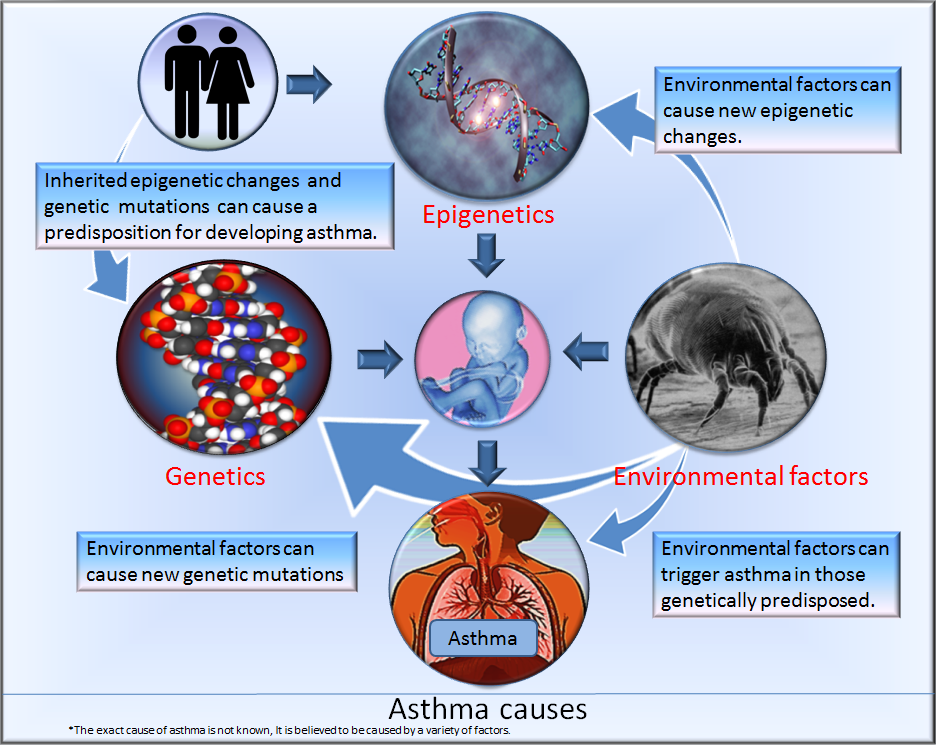What is the cause of asthma?
Reduced exposure in early life to microbes and microbial products is thought to cause asthma. People who were raised on farms and who attended out-of-home daycare earlier have fewer and less severe atopic disorders. The notion of “atopic disorder” describes a wide range of genetically mediated allergic diseases. The list includes allergic rhinitis, asthma, and atopic dermatitis (AD) associated with heightened T-helper type 2-driven inflammatory responses to common allergens, especially inhaled and food allergens.
The exact causes of asthma are not yet known. Many different reasons may contribute to asthma. Many environmental factors may trigger asthma in people sensitive to this atopic disorder.

(Source: https://simple.wikipedia.org/wiki/Asthma).
Bacterial DNA, which differs from mammalian DNA in the frequency of cytosine-guanine (CpG) dinucleotides, is an immune-stimulating substance. CpG oligonucleotides (CpG ODNs) induce type 1 T helper (Th1) cells to produce Th1 cytokines (interferon-γ, interleukin-2, and tumor necrosis factor-β) to activate macrophages. Macrophages are responsible for cell-mediated immunity and phagocyte-dependent protective responses.
Scientists have speculated that CpG ODNs may help prevent or reverse the white blood cell-linked (eosinophilic) inflammation of atopic asthma. Inducing the regulatory-type responses of T cells and antigen-presenting cells with CpG ODNs is thought to protect against atopic diseases such as asthma. Ongoing clinical trials examine CpG ODNs used alone and as adjuvants for immunotherapy in human populations with atopic diseases.
Bacterial and viral DNA oligodeoxynucleotides containing unmethylated cytosine-guanine (CpG) dinucleotides are found much more frequently than in vertebrates. These strongly immune-active CpG ODNs induce the proliferation and activation of B cells.
In recent decades, research scientists identified additional specific immune responses to CpG dinucleotide DNA in molecular pathways linking recognition of the CpG ligand with its effects. A limited number of human immune cells, most notably plasmacytoid DCs and B cells, constitutively express the receptor for CpG DNA, TLR-9.
CpG DNA enters cells through a process called endocytosis, in which cells absorb external substances by engulfing them with the cell membrane. After entering the cell, TLR-9 recognizes CpG oligonucleotides and translocate them to the nucleus, where they activate the nuclear factor-κB.
The early effects of exposure primarily lead to increased innate immune responses. Activated B cells and plasmacytoid DCs release IL-10, type-I IFNs, IL-12, IFN-inducible protein-10, and other cytokines and chemokines, inducing a regulatory/Th1-oriented inflammatory milieu.
Natural killer cells, T cells, and others that amplify and modulate the immune response react to these molecules. The induction of costimulatory receptors, immunoglobulin isotype switching by B-cells, and the activation of a cascade of cellular responses promoting adaptive immune responses are later effects.
Reference
Akira S. TLR signaling. Curr Top Microbiol Immunol 2006;311:1–16. [PubMed]
Bellanti JA, Settipane RA. The atopic disorders and atopy … "strange diseases" now better defined! Allergy Asthma Proc. 2017 Jul 1;38(4):241-242. [PMC]
Berger A. Th1 and Th2 responses: what are they? BMJ. 2000 Aug 12;321(7258):424. [PMC]
Creticos PS, Schroeder JT, Hamilton RG, Balcer-Whaley SL, Khattignavong AP, Lindblad R, Li H, Coffman R, Seyfert V, Eiden JJ, et al. Immunotherapy with a ragweed-Toll-like receptor 9 agonist vaccine for allergic rhinitis. N Engl J Med 2006;355:1445–1455. [PubMed]
Hemmi H, Takeuchi O, Kawai T, Kaisho T, Sato S, Sanjo H, Matsumoto M, Hoshino K, Wagner H, Takeda K, et al. A Toll-like receptor recognizes bacterial DNA. Nature 2000;408:740–745. [PubMed]
Kline JN. Eat dirt: CpG DNA and immunomodulation of asthma. Proc Am Thorac Soc. 2007 Jul;4(3):283-8. [PMC]
Obermeier F, Strauch UG, Dunger N, Grunwald N, Rath HC, Herfarth H, Scholmerich J, Falk W. In vivo CpG DNA/toll-like receptor 9 interaction induces regulatory properties in CD4+CD62L+ T cells which prevent intestinal inflammation in the SCID transfer model of colitis. Gut 2005;54:1428–1436. [PMC] [PubMed]
Romagnani S. Th1/Th2 cells. Inflamm Bowel Dis. 1999 Nov;5(4):285-94. [PubMed]
Zeng, G., Zhang, G. & Chen, X. Th1 cytokines, true functional signatures for protective immunity against TB?. Cell Mol Immunol 15, 206–215 (2018). [CMI], [nature]
---...---